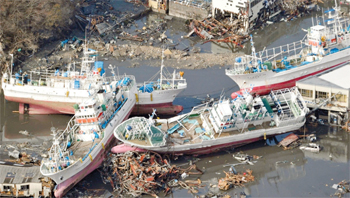US Navy ships helped search for survivors in the Pacific Ocean after Japan’s massive earthquake in March while several commercial vessels were swept aground and others told to steam far out to sea to escape floating debris, including complete houses.
The Nimitz class aircraft carrier USS Ronald Reagan (CVN 76) was one of the first on the scene to provided search and rescue operations as well as helicopters to land emergency supplies. Other US Navy ships dispatched to the area included the US 7th Fleet command ship USS Blue Ridge (LCC 19), the Military Sealift Command fleet replenishment oiler USNS Rappahannock (T-AO 204), the guided-missile destroyer USS Preble (DDG 88) and the Military Sealift Command dry cargo and ammunition ship USNS Matthew Perry (T-AKE 9).
Five bulk carriers operated by Tokyo’s ‘K’ Line were pushed aground, including the 175,775dwt China Steel Integrity, which was anchored at Kashima’s port with a full load of ore when the tsunami hit. The 32,385dwt bulker CS Victory, operated by compatriot owner Mitsui OSK Lines, was also pushed ashore at Ishinomaki after it had arrived to take on a load of Kaolin. NYK Line reported that three of its ships, the 91,439dwt Shiramizu, 77,739dwt Shirouma and 75,395dwt Coral Ring, had been damaged, with the Shirouma left aground at Haramati and Coral Ring damaged after being pushed against a pier at Onaham. One of the more widely photographed ships was the blue-hulled 6,175dwt general cargo vessel Asia Symphony, pushed onto a pier at Kamaishi. This ship, built in 1998, was erroneously reported by the Daily Mail as being of 175,0000 tonnes.


